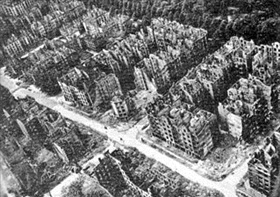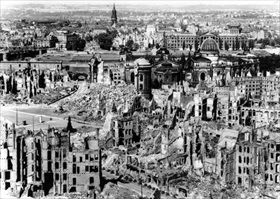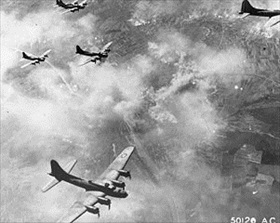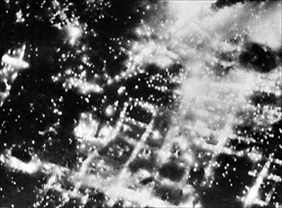U.S., BRITISH AIR FORCES KICK OFF COMBINED BOMBER OFFENSIVE
London, England • June 10, 1943
On this date in 1943 U.S. and British air forces unleashed their Combined Bomber Offensive (CBO) against industrial targets valuable to Nazi Germany’s war machine, particularly to the Luftwaffe. The CBO had several antecedents. In late 1942 both the British and the Americans had identified “bottleneck” German industries (Great Britain) or were preparing targeting plans (U.S.) whose purpose was to destroy and dislocate German military, industrial, and economic assets, thereby undermining the enemy’s capacity and capability to prosecute the air war against the Royal Air Force and the U.S. Eighth Air Force stationed in Great Britain. The Casablanca directive of February 4, 1943, a byproduct of the meeting British Prime Minister Winston Churchill and U.S. President Franklin D. Roosevelt held in Morocco the month before, led to Lt. Gen. Ira Baker, head of Eighth Air Force, signing off on a plan for Combined Bomber Operations in April 1943. On June 14, 1943, the Anglo-American Combined Chiefs of Staff issued the Pointblank Directive, which modified the February Casablanca directive. Pointblank’s highest priority targets were Germany’s fighter aircraft factories, largely because the Western Allies’ invasion of continental Europe, tentatively planned for sometime in 1944, required utmost Allied fighter superiority.
The June 1943 Combined Bomber Offensive began during the RAF’s bombing campaign against Germany’s arms industry in the Ruhr area of Northwestern Germany. However it wasn’t until Operation Gomorrah, the late July–early August 1943 round-the-clock bombing of Hamburg, a major port and industrial center on the Elbe River 70 miles/113 km inland from the North Sea, that the 2 nations’ air forces coordinated a raid on the same location and bombing targets: factories, U‑boat construction yards and pens, oil refineries, and storage depots. The sustained weeklong bombing assault (U.S. heavy bombers unloading their payloads during daylight hours, RAF unloading theirs at night) severely shook the Nazi leadership.
At the start of 1944 Maj. Gen. Jimmy Doolittle succeeded Eaker as the head of the Eighth Air Force. As part of the Combined Bomber Offensive, the Eighth Air Force launched Operation Argument, a series of bombing missions that became known as “Big Week.” Between February 20 and 25, 1944, more than 1,000 B‑17 Flying Fortresses and B‑24 Liberators, protected by over 800 P‑47 Thunderbolts and P‑51 Mustangs, targeted the German aircraft industry. Their raids caused so much damage that the Germans were forced to disperse aircraft manufacturing eastward, to safer parts of the Reich, as well as disperse more than 2 dozen larger works of its aircraft industry across many hundreds of medium and very small plants, some set up in caves, mines, and tunnels.
The Pointblank Directive, whose priority targets were Germany’s fighter aircraft factories, expired within days of the successful D-Day landings in Normandy, France. The Combined Bomber Offensive now directed its zeal and anger at German rocket and missile weapons factories in June 1944 and against oil and synthetic petroleum plants in September of the same year. On April 12, 1945, 2 weeks before Adolf Hitler ended his dream of a Thousand Year Reich by putting a bullet in his head, the Combined Bomber Objective ceased operations. Between the RAF’s Bomber Command and the U.S. Army Eighth and Ninth Air Forces operating from bases in Great Britain and later France and Belgium, 84,268 aircrew flying the bombers and fighter escorts that helped bring closure to the war in Europe had been killed or lost in pursuit of that end.
![]()
Inflicting Material Destruction from the Air: Examples from Combined Bomber Offensive
 |  |
Left: Called the “Hiroshima of Germany” by British officials, Operation Gomorrah (the biblical moniker seems an apt choice) was at the time the heaviest assault in the history of aerial warfare. The air assault destroyed a significant percentage of Hamburg. Ten square miles/26 square kilometers of the city were reduced to rubble, over 214,350 dwellings out of 414,500 were destroyed, over 1 million residents were rendered homeless, and 40,000–50,000 civilians were killed, with another 37,000 wounded. The city’s labor force was reduced permanently by 10 percent. The industrial losses were equally severe: 183 large factories and 4,118 smaller factories were put out of commission and Hamburg never recovered to full production. Losses to the city’s infrastructure were staggering: 90 percent of its gas works, 60 percent of its water system, and 75 percent of its electric works were destroyed. In the immediate wake of the raids, over two-thirds of Hamburg’s population, approximately 1.2 million people, fled the city. The Allies’ Hamburg raids led Hitler, who could never bring himself to see the destruction first hand, to be concerned that similar raids on other German cities could force his nation out of the war.
![]()
Right: The ruins of Dresden’s city center (“Altstadt”). Dresden was home to 127 medium-to-large factories and workshops that supplied the German Army with matériel (per the German Weapons Office), such as aircraft engines, machine tools, small arms, optical instruments, and poison gas, and employed 50,000 workers. Some 1,249 British and American bombers unloaded more than 3,900 tons of incendiary and high-explosive bombs on the center of the city, causing a firestorm that incinerated 15 square miles/39 square kilometers and between 22,700 and 25,000 people. Temperatures inside Dresden’s famous cathedral, the Frauenkirche (Church of Our Lady), reached an estimated 1,832°F (1,000°C) before the 300‑ft./92‑m‑tall church collapsed. Later the U.S. Eighth Air Force dropped 2,800 more tons of bombs on Dresden in 3 other attacks before the war’s end.
 |  |
Left: 1st Bomb Wing B-17s over Schweinfurt, Germany, August 17, 1943. The Schweinfurt-Regensburg mission entailed 2 large forces of U.S. Eight Air Force bombers (376 bombers in 16 bomb groups without long-range fighter escorts) attacking separate targets, both in Bavaria, with orders to cripple German fighter aircraft production. (German fighter output in July 1943 exceeded 1,200 planes.) The “double-strike mission” deep inside Germany inflicted heavy damage on the Messerschmitt factory at Regensburg but not on Schweinfurt’s ball-bearing factories, for a catastrophic loss to the force: 60 bombers shot down, 87 shot up beyond repair, and 557 airmen missing in action or captured. A planned follow-up raid on Schweinfurt had to be postponed to rebuild American forces. The second raid by 291‑still-unescorted B‑17s on October 14, 1943, on the ball-bearing production center at Schweinfurt proved even more catastrophic: 77 bombers lost, 121 damaged, and over 650 crewmen captured or killed. Just over 11 percent of the bomber force returned to base unscathed. During the course of the war more than 5,000 B‑17s were shot down by German fighter planes or flak batteries. In the memory of 1 U.S. airman, a 19‑year-old tail gunner on a B‑17, “flak was worse than fighters” when it came to surviving a bombing run over Germany.
![]()
Right: Braunschweig, whose industrial sector was targeted during “Big Week” (February 20–25, 1944), was completely laid to waste by the RAF on the night of October 14/15, 1944, in an operation that rivaled the hellish firebombing of Hamburg (Operation Gomorrah) the year before. The city burned continuously for two and a half days.
Contemporary Newsreel of Hamburg’s Devastation by Anglo-American Bombers During and After Operation Gomorrah, July–August 1943
![]()

 History buffs, there is good news! The Daily Chronicles of World War II is now available as an ebook for $4.99 on Amazon.com. Containing a year’s worth of dated entries from this website, the ebook brings the story of this tumultuous era to life in a compelling, authoritative, and succinct manner. Featuring inventive navigation aids, the ebook enables readers to instantly move forward or backward by month and date to different dated entries. Simple and elegant! Click
History buffs, there is good news! The Daily Chronicles of World War II is now available as an ebook for $4.99 on Amazon.com. Containing a year’s worth of dated entries from this website, the ebook brings the story of this tumultuous era to life in a compelling, authoritative, and succinct manner. Featuring inventive navigation aids, the ebook enables readers to instantly move forward or backward by month and date to different dated entries. Simple and elegant! Click 











